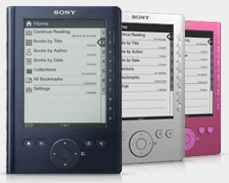Sony Pocket eBook Reader
 For the past few years I have reading eBooks on my HTC touch phone. On and off I have debated buying an eReader and recently purchased a Sony PRS-300 (eReader Pocket Edition). While I was happy using my HTC phone to read, I didn't realize what I was missing. Using the Sony eReader makes a world of difference.
For the past few years I have reading eBooks on my HTC touch phone. On and off I have debated buying an eReader and recently purchased a Sony PRS-300 (eReader Pocket Edition). While I was happy using my HTC phone to read, I didn't realize what I was missing. Using the Sony eReader makes a world of difference.
The eReader uses E Ink technology making the text really clear. There's a nice amount of text on each page and using the device is simple. Purchasing and downloading books is easy and the device can hold two or three hundred books. Above all it is really pleasurable to read on the device.
Before settling on the PRS-300 I looked at the Amazon Kindle and Sony Touch (PRS-600) eReader. The biggest problem with the Kindle (besides not looking to good) is that you are restricted to purchasing only from Amazon. A lot of people complain about glare on the Sony Touch due to the touch screen coating. I handled a Sony Touch for a while and the glare is an issue.
To me the PRS-300 looks better than the Kindle and not being a touch screen does not suffer from glare like the Sony Touch. It does not have the bells and whistles of the Kindle/Touch. It simply lets you read books - which is all I wanted.
To get books onto the reader you need to connect to a PC via USB (which also charges the reader). First time the reader is connected, Sony eReader software is installed on the computer. Purchase a book online (so far I have only Waterstones ), click the download button and a few seconds later the book is in the eReader software. It's that easy.
I purchased the dark blue PRS-300 with the optional black leather cover and it looks great. After owing it for a few weeks I can easily see why these are one of the hottest must have gadgets around. Anyone who likes reading should seriously consider one.